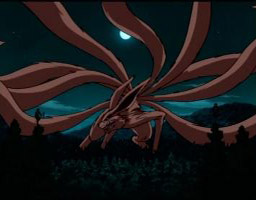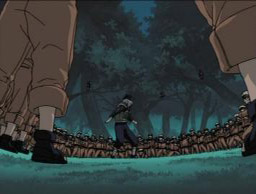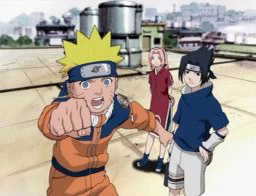|
Naruto is the teen animé phenomenon of this century. It
started in 1999 as a manga in the popular Shonen Jump monthly
anthology magazine, and became that magazine's most popular
serial, eclipsing even Yu-Gi-Oh!. Inevitably made
into an animé serial in 2002, it exploded onto the
mainstream animé scene and became even more popular
in the western world. Now, Manga Entertainment in the UK
is releasing both the English-dubbed and original Japanese
versions in one collection, completely unedited from the
original US TV broadcasts. Volume 1 goes on sale on the
21st of August, and is a three-disc set comprising the first
thirteen episodes of the series.

In
my review for Robotech,
I mentioned that animé that has been targeted at
teenagers is often edited to comply with US television "standards
and practices" – i.e. no nudity or sexual suggestiveness
and no explicit violence or language. Of all the animé
localisation companies currently at work in America, none
are more reviled than 4Kids, who infamously "butchered"
the popular animé One Piece. A collective
sigh of relief was heard throught the animé community
– who had assumed that, given the nature of the series,
4Kids would snap it up – when it was announced that Viz
Media, the producers of Shonen Jump, would be handling localisation
and dubbing work themselves. With a long history of good
localisation work under their belt – Ranma 1/2, She,
The Ultimate Weapon, Fullmetal Alchemist
– it would seem that fans have nothing to worry about.
That
said, edits were made to the original Japanese edition
of the series, and mostly along the lines mentioned above
– limited violence, language, nudity etc. The episodes of
Naruto currently showing on the Jetix channel in
the UK follows the US TV edits, but includes further edits
of its own. So Viz and Manga's decision to release an uncut
version of the series could be construed as either a cynical
marketing ploy designed to milk DVD sales out of obsessed
young fans eager for uncut action, or an attempt to get
English dubbers back on animé fans' "good side",
as it were. All too often, American localisation firms create
an edited TV edition and ignore fans' calls for unedited
DVD releases.
Whatever
the motive, Naruto is now here on Region 2 DVD. I
suppose the burning question is: does it live up to the
hype and popularity? Well, it all depends on your point
of view. I must admit that I myself was dismissive of the
series when I first heard about it, seeing it as little
more than a kids' animé series along the lines of Dragon Ball Z. But like so many things, if you're
willing to sit down and give it a chance, you might be surprised.
The
series' protagonist is the titular Naruto Uzumaki, a twelve-year-old
boy. When he was born, his village was under attack by a
nine-tailed demon fox – to save the village, the elite ninja
warriors sealed the spirit of the fox inside of the newborn
Naruto. Having grown up with no family, and always mistrusted
by the people of his village due to his connection to the
demon, Naruto has become somewhat of an outcast amongst
his own people – and he doesn't know why. This leads him
to become a mischeivous troublemaker of a trainee ninja,
who doesn't take his studies seriously and is always bottom
of his class. It is only when he is told the truth about
his past by the duplicitous ninja Mizaki that Naruto begins
to understand his true potential and start trying to do
his very best. Along with his friends Sasuke and Sakura,
Naruto strives to find recognition and acceptance, and aims
to be the greatest ninja warrior in the village.

The
main focus of the series is on characterisation. Like Pokémon,
there is a moral lesson running through each of the episodes,
even when the plot and setting of Naruto is applied
to it. Themes include acceptance of outsiders, loneliness,
discrimination and loyalty to others, including teamwork
and friendship even when you don't get along with your teammates
at first. As a series, the intention is often to be dramatic,
but it also manages a healthy dose of comedy – often of
the slapstick variety – and humour through dialogue and
situation. The first thirteen episodes contained on this
disc (half of the current run that's airing on Jetix at
the moment) set up the characters and situations of the
rest of the series, looking mosty at Naruto and his friends'
ninja studies. In general, it works: the viewer can, depending
on his or her taste, see the series as an action-driven
fantasy, or look closer to see the deeper meanings and themes
behind each of the episodes.
Viz's
English dub is good, but not exceptional. It suffers from
a common problem with animé dubbing – the Speed
Racer-esque lip-synching difficulty that leads the dub
voice actors to speaking many lines very fast, or adding
unnatural pregnant pauses into sentences that should flow
more smoothly. A qualm I had at with the dub at first was
Naruto's voice, which is simply irritating – it's whiny
and overexcited, which at first I didn't think would fit
the character. However, switching over to the Japanese language
track for a few minutes, I could hear that Naruto's Japanese
voice used almost the same inflection. Kudos, of course,
to Viz, for finding an English voice that was similar to
the Japanese one, but I still stand by my opinion.
Naruto's
animation is clean and sharp, but then I wouldn't expect
anything less from a modern series. Characters are drawn
well, with a variety of interesting designs on the traditional
"ninja" theme. A technique that's often used is to have
the characters' facial features become exaggerated in moments
of emotion; although typical of many animé, it does
serve to emphasise the fantasy of this animé's world,
as opposed to the realistic animation of, say, Otogi
Zoshi. A technique that's used for Sakura, Naruto's
female friend, is to draw her "inner feelings" as black-and-white
line drawings with exaggerated proportions; it's often played
for laughs and seems to work well. Finally, the background
buildings of the village – especially the main council building
– are drawn and coloured in a style that's reminiscent of
Studio Ghibli's award-winning art style.

You
may call it what you want – you can say it's juvenile, derivative,
unoriginal – but the fact remains that Naruto wouldn't
be as popular as it is if it wasn't in some way good. And
in the end, no matter what age you are, it's still good
entertainment. Even though the storyline and themes may
cater more to a younger audience, there's nothing stopping
adult animé watchers from just kicking back and enjoying
it.
Framed
in the original 4:3, the transfer is a good one, with a
clear, clean picture and soliod colour reproduction. None
of the usual telltale signs of an NTSC to PAL transfer are
evident, suggesting a possible PAL master for a change.
Dolby
2.0 stereo, surround 5.1 and DTS tracks are available for
the original Japanese and the English dub. The stereo tracks
are louder than you'd usually expect for Dolby 2.0, and
the English voices are louder and clearer than the Japanese.
The DTS track is very loud and a little shrill at times.
Both this and the 5.1 track are mainly front and centre,
with no evidence of a proper remix.
The
subtitles present a considerably simplified version of the
Japanese dialogue, but are clear and easily read.
Manga
is marketing Naruto as a big seller, and so has packaged
the DVD exceptionally well – with a special slip case and
storyboards booklet included with the discs. The special
features on the discs themselves are more run-of-the-mill.
Firstly, there's a short feature called From Animé
to Manga, which appears to showcase part of an
isolated scene and then overlays it with an effect that
makes it look like a printed manga. This isn't convincing
at all, and I can't honestly see the point of it. There's
the usual textless opening and ending,
plus trailers for Karas,
Heat Guy J,
Robotech and
Naruto itself (albeit the TV trailer from Jetix).
|